The Influence of ENSO and MJO on Drought in Different Ecological Geographic Regions in China
Abstract
1. Introduction
2. Materials and Methods
2.1. Study Area and Data
2.1.1. Basic and Meteorological Data
2.1.2. Remote Sensing Data
2.1.3. Climatic Indices
2.2. Methods
2.2.1. Calculation of Drought Indices
2.2.2. Statistic and Spatiotemporal Analysis of Correlation
2.2.3. Spatiotemporal Analysis of Correlation
2.2.4. Zonal Statistics
3. Result
3.1. Both ENSO and MJO Oscillations Influenced Drought in Various Ecological Geographical Regions
3.2. ENSO and MJO Oscillations Have a Significant Correspondence with Drought in the Long-Term Series
4. Discussion
5. Conclusions
Author Contributions
Funding
Acknowledgments
Conflicts of Interest
References
- Mitchell, J.K.; Bryant, E.A. Natural Hazards. Geogr. Rev. 1992, 82, 478. [Google Scholar] [CrossRef]
- Field, C.; Barros, V.; Change, I. Climate Change 2014: Impacts, Adaptation, and Vulnerability: Working Group II Contribution to the Fifth Assessment Report of the Intergovernmental Panel on Climate Change; IPCC: Geneva, Switzerland, 2014. [Google Scholar]
- Almazroui, M.; Saeed, S.; Saeed, F.; Islam, M.N.; Ismail, M. Projections of Precipitation and Temperature over the South Asian Countries in CMIP6. Earth Syst. Environ. 2020, 4, 297–320. [Google Scholar] [CrossRef]
- Dai, A. Drought under global warming: A review. Wiley Interdiscip. Rev. Clim. Chang. 2010, 2, 45–65. [Google Scholar] [CrossRef]
- Pereira, M.P.S.; Mendes, K.R.; Justino, F.; Couto, F.; Da Silva, A.S.; Da Silva, D.F.; Malhado, A.C.M. Brazilian Dry Forest (Caatinga) Response To Multiple ENSO: The role of Atlantic and Pacific Ocean. Sci. Total. Environ. 2020, 705, 135717. [Google Scholar] [CrossRef] [PubMed]
- Júnior, R.D.S.N.; Fraisse, C.W.; Karrei, M.A.Z.; Cerbaro, V.A.; Perondi, D. Effects of the El Niño Southern Oscillation phenomenon and sowing dates on soybean yield and on the occurrence of extreme weather events in southern Brazil. Agric. For. Meteorol. 2020, 290, 108038. [Google Scholar] [CrossRef]
- Brum, M.; Oliveira, R.S.; López, J.G.; Licata, J.; Pypker, T.; Chia, G.S.; Tinôco, R.S.; Asbjornsen, H. Effects of irrigation on oil palm transpiration during ENSO-induced drought in the Brazilian Eastern Amazon. Agric. Water Manag. 2021, 245, 106569. [Google Scholar] [CrossRef]
- Hamdi, R.; Kusaka, H.; Doan, Q.-V.; Cai, P.; He, H.; Luo, G.; Kuang, W.; Caluwaerts, S.; Duchêne, F.; Van Schaeybroek, B.; et al. The State-of-the-Art of Urban Climate Change Modeling and Observations. Earth Syst. Environ. 2020, 4, 631–646. [Google Scholar] [CrossRef]
- Santoso, A.; Mcphaden, M.J.; Cai, W. The Defining Characteristics of ENSO Extremes and the Strong 2015/2016 El Niño. Rev Geophys. 2017, 55. [Google Scholar] [CrossRef]
- Wang, H.; Kumar, A. Assessing the impact of ENSO on drought in the U.S. Southwest with NCEP climate model simulations. J. Hydrol. 2015, 526, 30–41. [Google Scholar] [CrossRef]
- Lyon, B.; Cristi, H.; Verceles, E.R.; Hilario, F.D.; Abastillas, R. Seasonal reversal of the ENSO rainfall signal in the Philippines. Geophys. Res. Lett. 2006, 33. [Google Scholar] [CrossRef]
- Gelcer, E.; Fraisse, C.W.; Dzotsi, K.; Hu, Z.; Mendes, R.; Zotarelli, L. Effects of El Niño Southern Oscillation on the space–time variability of Agricultural Reference Index for Drought in midlatitudes. Agric. For. Meteorol. 2013, 174–175, 110–128. [Google Scholar] [CrossRef]
- Bellenger, H.; Duvel, J.-P. The event-to-event variability of the boreal winter MJO. Geophys. Res. Lett. 2012, 39, 8701. [Google Scholar] [CrossRef]
- Zaitchik, B.F. Madden-Julian Oscillation impacts on tropical African precipitation. Atmospheric Res. 2017, 184, 88–102. [Google Scholar] [CrossRef]
- Hidayat, R. Modulation of Indonesian Rainfall Variability by the Madden-julian Oscillation. Procedia Environ. Sci. 2016, 33, 167–177. [Google Scholar] [CrossRef]
- Gupta, V.; Jain, M.K. Unravelling the teleconnections between ENSO and dry/wet conditions over India using nonlinear Granger causality. Atmospheric Res. 2021, 247, 105168. [Google Scholar] [CrossRef]
- Le, J.A.; El-Askary, H.M.; Allali, M.; Sayed, E.; Sweliem, H.; Piechota, T.C.; Struppa, D.C. Characterizing El Niño-Southern Oscillation Effects on the Blue Nile Yield and the Nile River Basin Precipitation using Empirical Mode Decomposition. Earth Syst. Environ. 2020, 4, 699–711. [Google Scholar] [CrossRef]
- Meza, F.J. Recent trends and ENSO influence on droughts in Northern Chile: An application of the Standardized Precipitation Evapotranspiration Index. Weather. Clim. Extremes 2013, 1, 51–58. [Google Scholar] [CrossRef]
- Shi, S.; Shi, J.; Xu, C.; Leavitt, S.W.; Wright, W.E.; Cai, Z.; Zhang, H.; Sun, X.; Zhao, Y.; Ma, X.; et al. Tree-ring δ18O from Southeast China reveals monsoon precipitation and ENSO variability. Palaeogeogr. Palaeoclim. Palaeoecol. 2020, 558, 109954. [Google Scholar] [CrossRef]
- Park, S.; Kang, D.; Yoo, C.; Im, J.; Lee, M.-I. Recent ENSO influence on East African drought during rainy seasons through the synergistic use of satellite and reanalysis data. ISPRS J. Photogramm. Remote. Sens. 2020, 162, 17–26. [Google Scholar] [CrossRef]
- Costa, M.D.S.; De Oliveira-Júnior, J.F.; Dos Santos, P.J.; Filho, W.L.F.C.; De Gois, G.; Blanco, C.J.C.; Teodoro, P.E.; Junior, C.A.D.S.; Santiago, D.D.B.; Souza, E.D.O.; et al. Rainfall extremes and drought in Northeast Brazil and its relationship with El Niño–Southern Oscillation. Int. J. Clim. 2021, 41. [Google Scholar] [CrossRef]
- Ortega, C.; Vargas, G.; Rojas, M.; Rutllant, J.A.; Muñoz, P.; Lange, C.B.; Pantoja, S.; Dezileau, L.; Ortlieb, L. Extreme ENSO-driven torrential rainfalls at the southern edge of the Atacama Desert during the Late Holocene and their projection into the 21th century. Glob. Planet. Chang. 2019, 175, 226–237. [Google Scholar] [CrossRef]
- Wicaksono, G.B.; Hidayat, R. Extreme Rainfall in Katulampa Associated with the Atmospheric Circulation. Procedia Environ. Sci. 2016, 33, 155–166. [Google Scholar] [CrossRef]
- Kalisa, W.; Zhang, J.; Igbawua, T.; Ujoh, F.; Ebohon, O.J.; Namugize, J.N.; Yao, F. Spatio-temporal analysis of drought and return periods over the East African region using Standardized Precipitation Index from 1920 to 2016. Agric. Water Manag. 2020, 237, 106195. [Google Scholar] [CrossRef]
- Li, W.; Zhai, P.; Cai, J. Research on the Relationship of ENSO and the Frequency of Extreme Precipitation Events in China. Adv. Clim. Chang. Res. 2011, 2, 101–107. [Google Scholar] [CrossRef]
- Wang, H.; Chen, Y.; Pan, Y.; Chen, Z.; Ren, Z. Assessment of candidate distributions for SPI/SPEI and sensitivity of drought to climatic variables in China. Int. J. Clim. 2019, 39, 4392–4412. [Google Scholar] [CrossRef]
- Ma, F.; Ye, A.; You, J.; Duan, Q. 2015–16 floods and droughts in China, and its response to the strong El Niño. Sci. Total. Environ. 2018, 627, 1473–1484. [Google Scholar] [CrossRef] [PubMed]
- Li, J. Impact of El Nino Phenomenon on Temperature and Precipitation in Eastern China. China-Arab States Sci. Technol. Forum 2020, 07, 113–115. [Google Scholar]
- Chen, X.; Li, C.; Li, X.; Yang, M.; Li, L. Modulation of the impacts of Madden–Julian Oscillation on winter rainfall in China by El Niño-Southern Oscillation. Int. J. Clim. 2020, 40, 4039–4052. [Google Scholar] [CrossRef]
- Liu, Z.; Zhang, X.; Fang, R. Multi-scale linkages of winter drought variability to ENSO and the Arctic Oscillation: A case study in Shaanxi, North China. Atmos. Res. 2018, 200, 117–125. [Google Scholar] [CrossRef]
- Wei, W.; Shuang, F. The Correlation Analysis between Summer Droughts & Floods in the Southwest and ENSO. J. Chengdu Univ. Inf. Technol. 2012, 27, 412–418. [Google Scholar]
- Zhou, S. Temporal and Spatial Evolution and Prediction of Meteorological Drought in the Poyang Lake Basin under Climate Change. Mastere’s Thesis, Nanchang Institute of Technology, Nanchang, China, 2019. [Google Scholar]
- Yang, S.-Y.; Li, T.; Niu, F.-B.; Ju, J.-H. Possible Impacts of the MJO on once Heavy Rain During Fall Drought of 2011 over Yunnan. J. Chengdu Univ. Inf. Technol. 2013, 28, 175–180. [Google Scholar]
- Yuan, W.; Yang, H. On the Modulation of MJO to the Precipitation of Southeast China in Winter Season. Acta Sci. Nat. Univ. Pekin. 2010, 46, 207–214. [Google Scholar]
- Zheng, Y.; Zhang, Q.; Luo, M.; Sun, P.; Singh, V.P. Wintertime precipitation in eastern China and relation to the Madden-Julian oscillation: Spatiotemporal properties, impacts and causes. J. Hydrol. 2020, 582, 124477. [Google Scholar] [CrossRef]
- Zhang, Q.; Zhang, L.; Cui, X.; Zeng, J. Progresses and Challenges in Drought Assessment and Monitoring. Adv. Earth Sci. 2011, 26, 763–778. [Google Scholar]
- Amin, Z.; Rehan, S.; Bahman, N.; Faisal, I.K. A review of drought indices. Environ. Rev. 2011, 19, 333–349. [Google Scholar]
- Du, L.; Tian, Q.; Yu, T.; Meng, Q.; Jancso, T.; Udvardy, P.; Huang, Y. A comprehensive drought monitoring method integrating MODIS and TRMM data. Int. J. Appl. Earth Obs. Geoinf. 2013, 23, 245–253. [Google Scholar] [CrossRef]
- Hao, Z.; Singh, V.P. Drought characterization from a multivariate perspective: A review. J. Hydrol. 2015, 527, 668–678. [Google Scholar] [CrossRef]
- Vicente-Serrano, S.M.; Beguería, S.; Lorenzo-Lacruz, J.; Camarero, J.J.; López-Moreno, J.I.; Azorin-Molina, C.; Revuelto, J.; Morán-Tejeda, E.; Sanchez-Lorenzo, A. Performance of Drought Indices for Ecological, Agricultural, and Hydrological Applications. Earth Interact. 2012, 16, 1–27. [Google Scholar] [CrossRef]
- McKee, T.B.N.; Doeskin, N.; Kleist, J. Drought Monitoring With Multiple Time Scales. In Proceedings of the 9th Conference on Applied Climatology, Dallas, TX, USA, 15–20 January 1995; pp. 233–236. [Google Scholar]
- Vicente-Serrano, S.M.; Beguería, S.; López-Moreno, J.I. A Multiscalar Drought Index Sensitive to Global Warming: The Standardized Precipitation Evapotranspiration Index. J. Clim. 2010, 23, 1696–1718. [Google Scholar] [CrossRef]
- Palmer, W.C. Meteorological Drought; US. Weather Bureau Research Paper; US Department of Commerce Weather Bureau: Washington, DC, USA, 1965; 45, p. 58.
- Wells, N.; Goddard, S.; Hayes, M.J. A self-calibrating Palmer drought severity index. J. Clim. 2004, 17, 2335–2351. [Google Scholar] [CrossRef]
- Kogan, F.N. Global Drought Watch from Space. Bull. Am. Meteorol. Soc. 1997, 78, 621–636. [Google Scholar] [CrossRef]
- Kogan, F. World droughts in the new millennium from AVHRR-based vegetation health indices. Eos 2002, 83, 557–563. [Google Scholar] [CrossRef]
- Liu, H.Q.; Huete, A. A feedback based modification of the NDVI to minimize canopy background and atmospheric noise. IEEE Trans. Geosci. Remote Sens. Appl. Soc. Environ. 1995, 33, 457–465. [Google Scholar] [CrossRef]
- Kogan, F. Application of vegetation index and brightness temperature for drought detection. Adv. Space Res. 1995, 15, 91–100. [Google Scholar] [CrossRef]
- Garen, D.C. Revised Surface-Water Supply Index for Western United States. J. Water Resour. Plan. Manag. 1993, 119, 437–454. [Google Scholar] [CrossRef]
- Jackson, R.D.; Idso, S.B.; Reginato, R.J.; Pinter, P.J. Canopy temperature as a crop water stress indicator. Water Resour. Res. 1981, 17, 1133–1138. [Google Scholar] [CrossRef]
- Zhou, L.; Zhang, J.; Wu, J.; Zhao, L.; Liu, M.; Lü, A.; Wu, Z. Comparison of remotely sensed and meteorological data-derived drought indices in mid-eastern China. Int. J. Remote. Sens. 2011, 33, 1755–1779. [Google Scholar] [CrossRef]
- Liang, L.; Zhao, S.-H.; Qin, Z.-H.; He, K.-X.; Chen, C.; Luo, Y.-X.; Zhou, X.-D. Drought Change Trend Using MODIS TVDI and Its Relationship with Climate Factors in China from 2001 to 2010. J. Integr. Agric. 2014, 13, 1501–1508. [Google Scholar] [CrossRef]
- Shaohong, W.; Qinye, Y.; Du, Z. Delineation of eco—geographic regional system of China. J. Geogr. Sci. 2003, 13, 309–315. [Google Scholar] [CrossRef]
- Resource and Environment Science and Data Center. Available online: http://www.resdc.cn/data.aspx?DATAID=125 (accessed on 11 January 2021).
- Du, Z.; Fao, R. A Study on the Eco-Geographic Regional System of China. In Proceedings of the FAO FRA2000 Global Ecological Zoning Workshop, Cambridge, UK, 28–30 January 1999. [Google Scholar]
- China Meteorological Data Network. Available online: http://data.cma.cn/ (accessed on 11 January 2021).
- National Oceanic and Atmospheric Administration. US Standard Atmosphere, 1976; National Oceanic and Atmospheric Administration: Washington, DC, USA, 1976; Volume 76.
- Kogan, F.N. Remote sensing of weather impacts on vegetation in non-homogeneous areas. Int. J. Remote. Sens. 1990, 11, 1405–1419. [Google Scholar] [CrossRef]
- National Climate Center of China Meteorological Administration. Available online: https://cmdp.ncc-cma.net/pred/cn_enso.php?product=cn_enso_nino_indices (accessed on 11 January 2021).
- Trenberth, K.E. The Definition of El Niño. Bull. Am. Meteor. Soc 1997, 78, 2771–2777. [Google Scholar] [CrossRef]
- Wheeler, M.C.; Hendon, H.H. An All-Season Real-Time Multivariate MJO Index: Development of an Index for Monitoring and Prediction. Mon. Weather Rev. 2004, 132, 1917–1932. [Google Scholar] [CrossRef]
- National Climate Center of America. Available online: https://www.cpc.ncep.noaa.gov/products/precip/CWlink/MJO/mjo.shtml (accessed on 11 January 2021).
- Ronghui, H. Progresses in Research on the Formation Mechanism and Prediction Theory of Severe Climatic Disasters in China. Adv. Earth Sci. 2006, 21, 564–575. [Google Scholar] [CrossRef]
- Li, Q.; Xue, Y. Simulated impacts of land cover change on summer climate in the Tibetan Plateau. Environ. Res. Lett. 2010, 5, 015102. [Google Scholar] [CrossRef]
- Zhou, C.; Li, Y.; Bu, Q.; Peng, J. Features of Drought-Flood Coexistence in West and East of of Sichuan-Chongqing Basin in Midsummer and Its Relating Background with Atmospheric Circulation. Plateau Meteorol. 2011, 30, 620–627. [Google Scholar]
- Wang, M.; Guo, J.-R.; Song, J.; Fu, Y.-Z.; Sui, W.-Y.; Li, Y.-Q.; Zhu, Z.-M.; Li, S.; Li, L.-L.; Guo, X.-F.; et al. The correlation between ENSO events and sea surface temperature anomaly in the Bohai Sea and Yellow Sea. Reg. Stud. Mar. Sci. 2020, 35, 101228. [Google Scholar] [CrossRef]
- Zhang, Z.; Chao, B.F.; Chen, J.; Wilson, C.R. Terrestrial water storage anomalies of Yangtze River Basin droughts observed by GRACE and connections with ENSO. Glob. Planet. Chang. 2015, 126, 35–45. [Google Scholar] [CrossRef]
- Cheng, Q.; Gao, L.; Zhong, F.; Zuo, X.; Ma, M. Spatiotemporal variations of drought in the Yunnan-Guizhou Plateau, southwest China, during 1960–2013 and their association with large-scale circulations and historical records. Ecol. Indic. 2020, 112, 106041. [Google Scholar] [CrossRef]
- Li, S.-Y.; Miao, L.-J.; Jiang, Z.-H.; Wang, G.-J.; Gnyawali, K.R.; Zhang, J.; Zhang, H.; Fang, K.; He, Y.; Li, C. Projected drought conditions in Northwest China with CMIP6 models under combined SSPs and RCPs for 2015–2099. Adv. Clim. Chang. Res. 2020, 11, 210–217. [Google Scholar] [CrossRef]
- Liu, Z.; Menzel, L.; Dong, C.; Fang, R. Temporal dynamics and spatial patterns of drought and the relation to ENSO: A case study in Northwest China. Int. J. Clim. 2015, 36, 2886–2898. [Google Scholar] [CrossRef]
- Wang, Z.; Wei, G.; Chen, J.; Liu, Y.; Ma, J.; Xie, L.; Deng, W.; Ke, T. El Nio–Southern Oscillation variability recorded in estuarine sediments of the Changjiang River, China. Quat. Int. 2017, 441, 18–28. [Google Scholar] [CrossRef]
- Ju, J.; Lv, J.; Xie, G.; Huang, Z. Studies on the Influences of Persistent Anomalies of MJO and AO on Drought Appeared in Yunnan. J. Arid Meteorol. 2011, 29, 401–406. [Google Scholar]



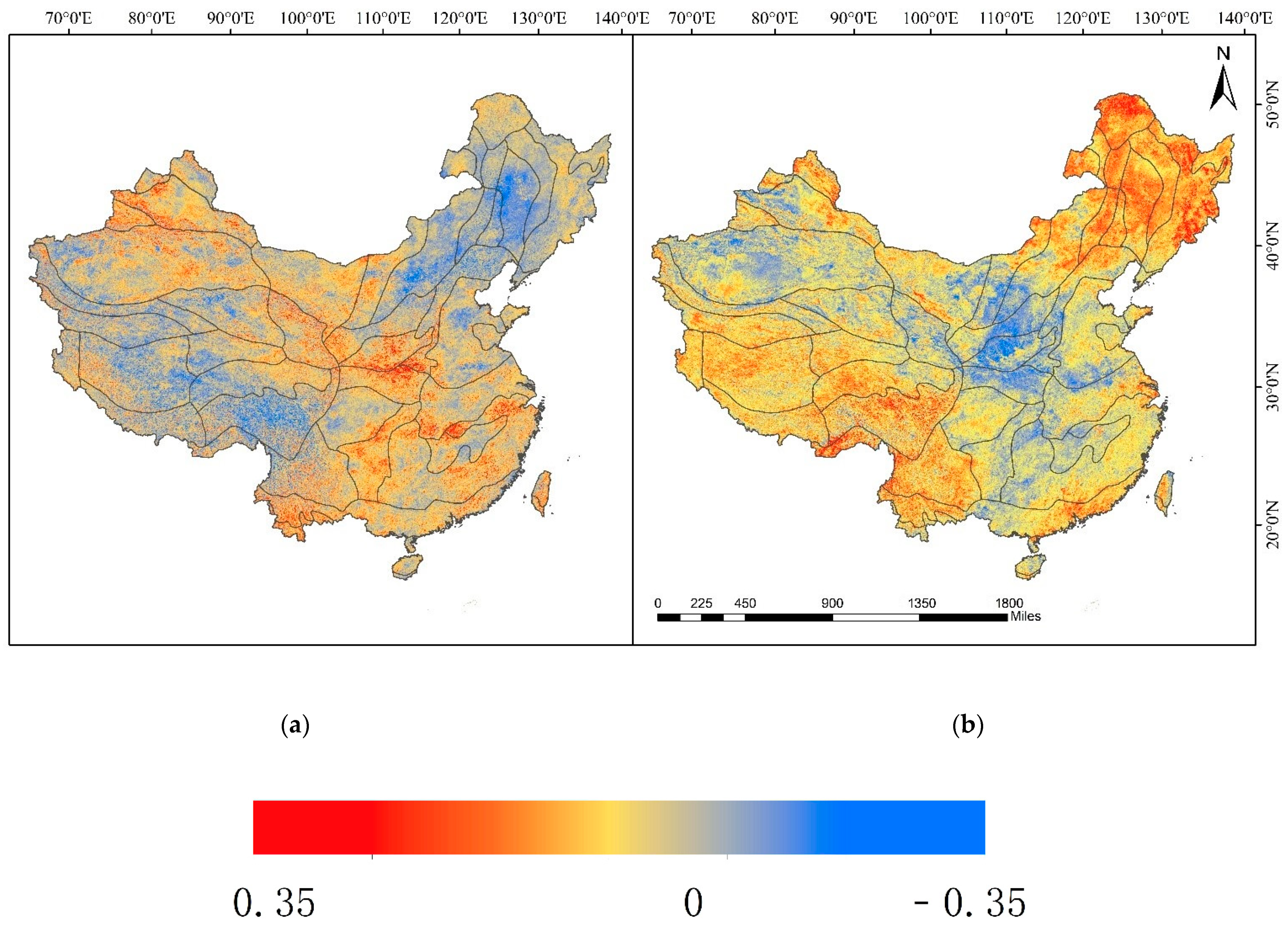
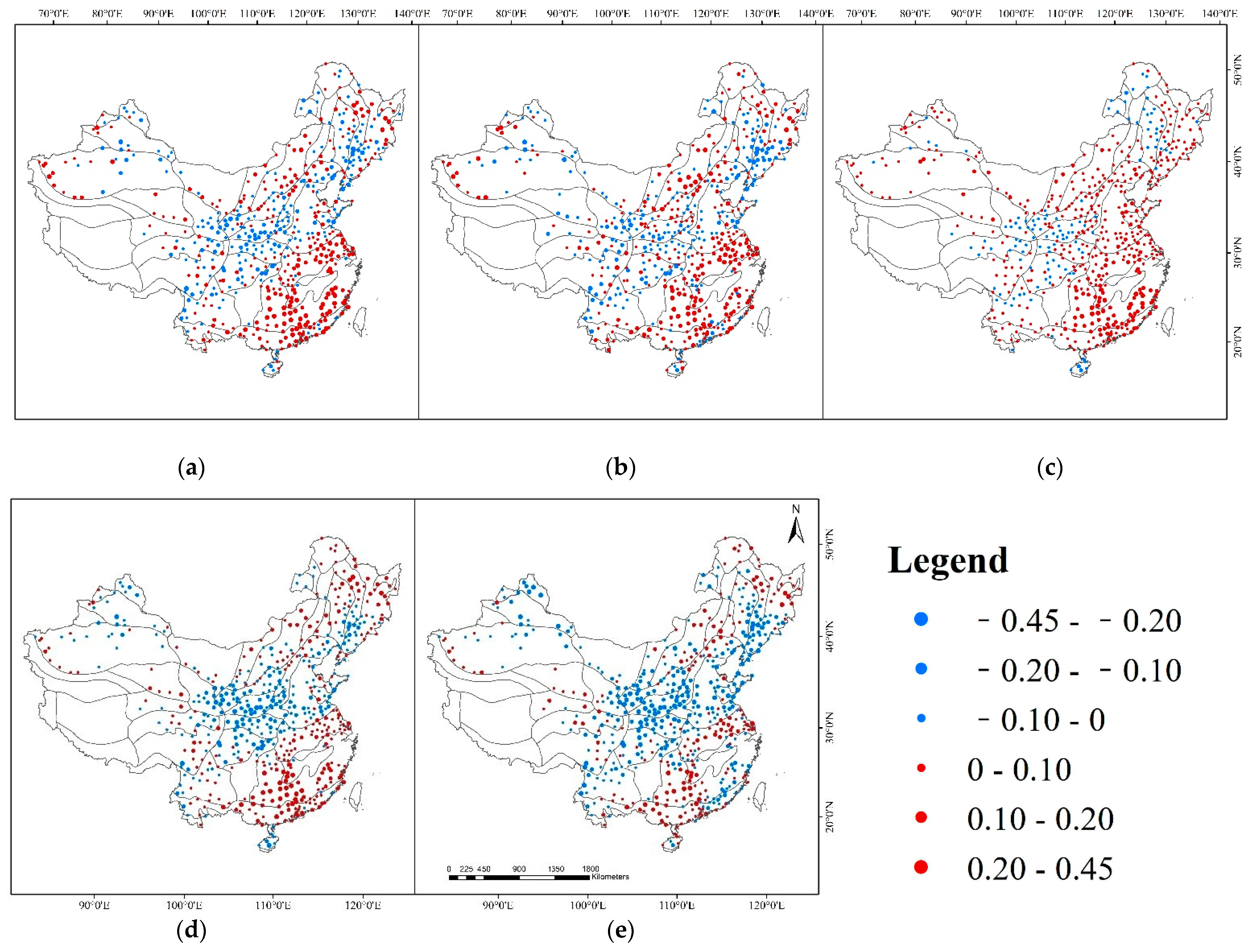
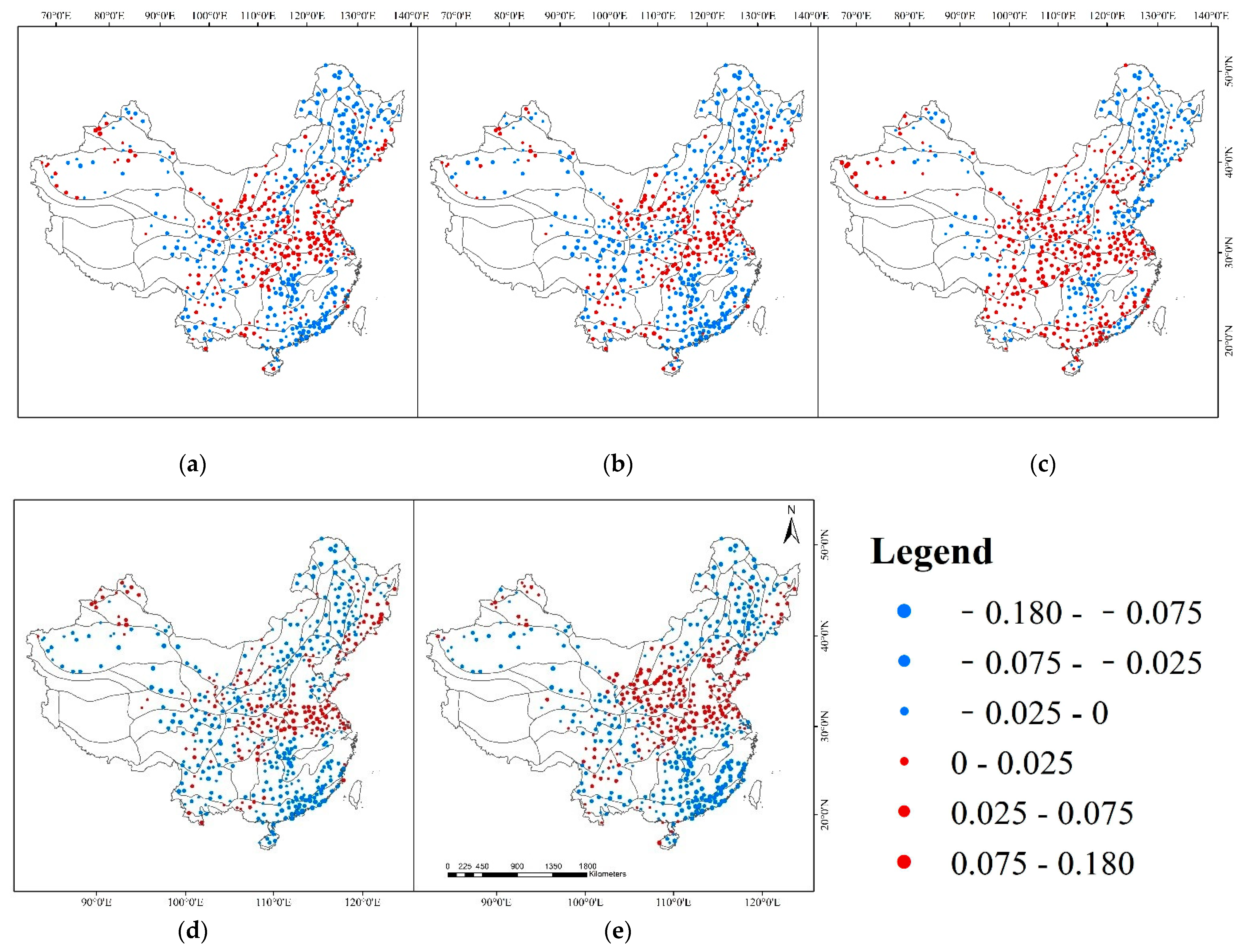
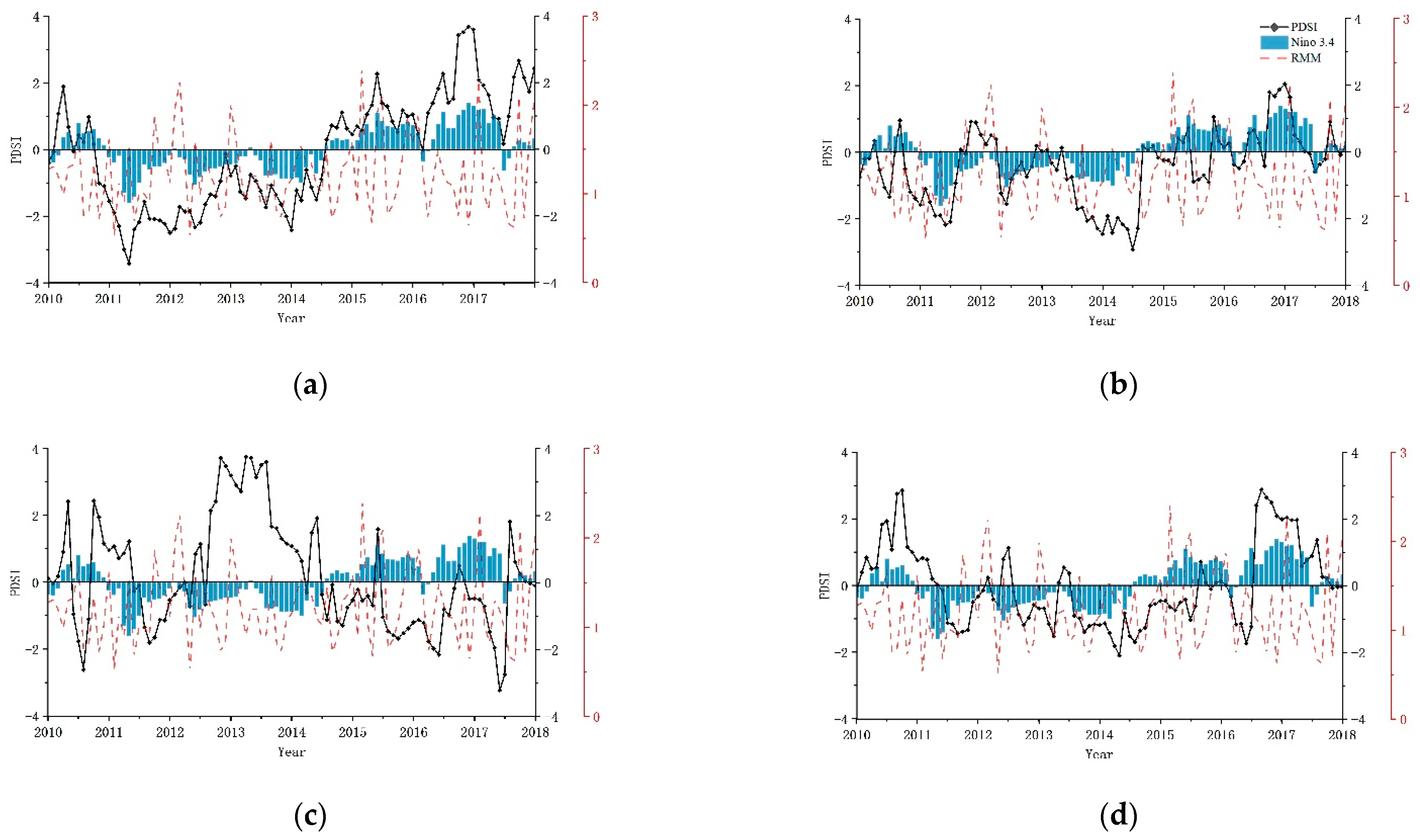
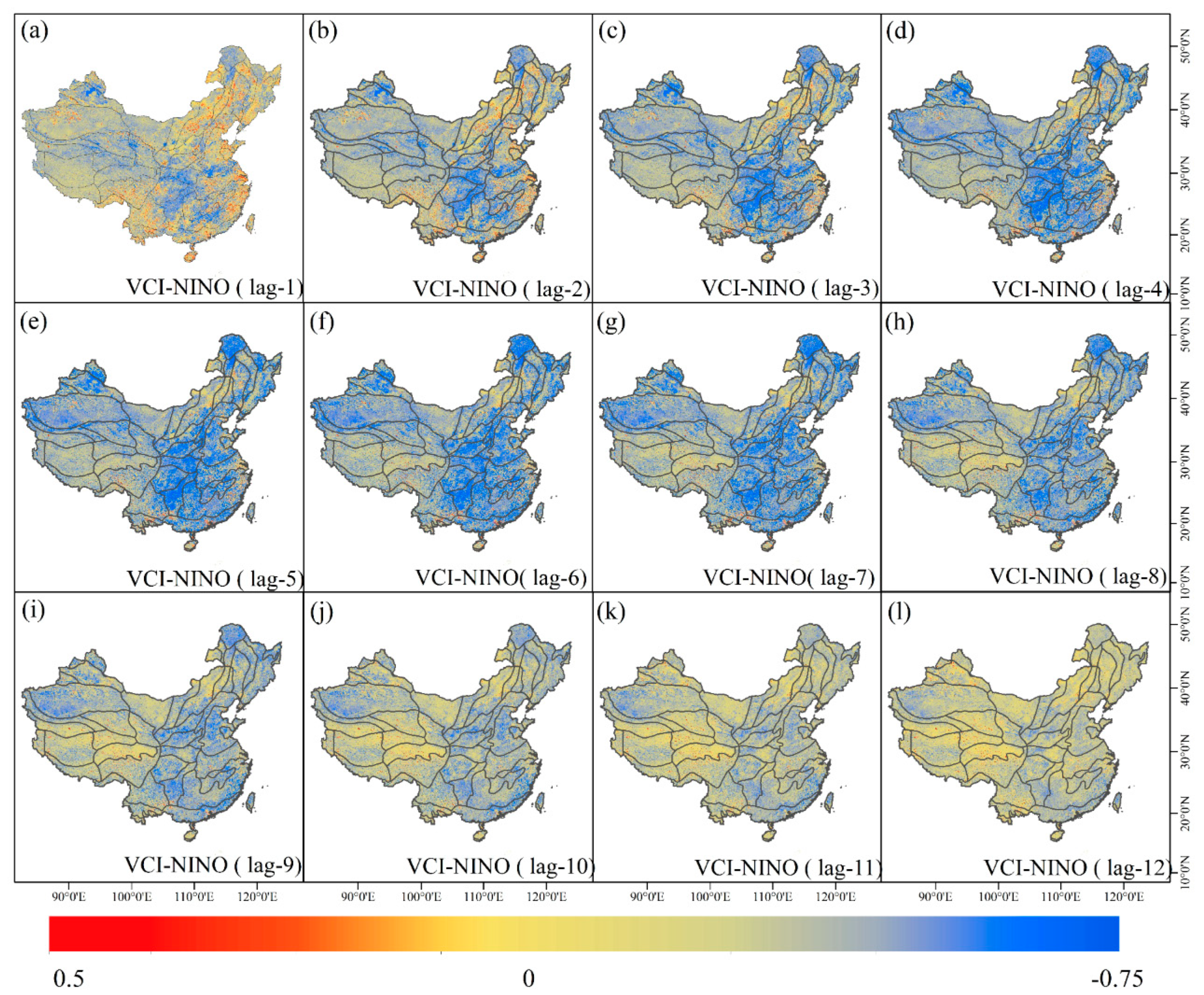
| Temperature Zone | Dry–Wet Partition | Natural Region |
|---|---|---|
| I Cool Temperate Zone | A Humid Region | IA1 Daxing’an Mountains |
| II Mid-Temperate Zone | A Humid Region | IIA1 Sanjiang Plain |
| IIA2 East Upland Area of Northeast China | ||
| IIA3 Front Mountain Plain of Eastern Northeast China | ||
| B Semi-Humid Region | IIB1 Central Songliao Plain | |
| IIB2 Southern Daxing’an Mountains | ||
| IIB3 Plain and Hills Sanhe Piedmont | ||
| C Semi-arid Region | IIC1 Southwestern Songliao Plain | |
| IIC2 Northern Daxing’an Mountains | ||
| IIC3 Eastern Inner Mongolia Plateau | ||
| IID1 Western Inner Mongolia Plateau and Hetao | ||
| IID2 Alxa and Hexi Corridor | ||
| D Arid Region | IID3 Junggar Basin | |
| IID4 Altai Mountain and Tacheng Basin | ||
| IID5 Ili River Basin | ||
| III Warm Temperate Zone | A Humid Region | IIIA1 Jiaodong Mountain Hills in Eastern Liaoning Province |
| B Semi-Humid Region | IIIB1 Mountain and Hills in Central Shandong | |
| IIIB2 North China Plain | ||
| IIIB3 Mountain and Hills in North China | ||
| IIIB4 Guanzhong Basin in South Shanxi | ||
| C Semi-arid Region | IIIC1 Hilly and Plateau in Central Shanxi, Northern Shanxi and Eastern Gansu | |
| D Arid Region | IIID1 Tarim and Turpan Basins | |
| IV Northern Subtropical Zone | A Humid Region | IVA1 South of the Huaihe River and Middle and Lower Reaches of the Yangtze River |
| IVA2 Hanzhong Basin | ||
| V Middle Subtropical Zone | A Humid Region | VA1 Jiangnan Hills |
| VA2 Jiangnan and Nanling Mountains | ||
| VA3 Guizhou Plateau | ||
| VA4 Sichuan Basin | ||
| VA5 Yunnan Plateau | ||
| VA6 South Limb of Eastern Himalayan | ||
| VI Southern Subtropical Zone | A Humid Region | VIA1 Mountain Plain in Central and Northern Taiwan |
| VIA2 Hilly Plain of Fujian, Guangdong and Guangxi | ||
| VIA3 Mountain Hills in Central Yunnan | ||
| VII Edge Tropical Zone | A Humid Region | VIIA1 Lowlands in Southern Taiwan |
| VIIA2 Mountain Hills in Qionglei | ||
| VIIA3 Valley Hills in South Yunnan | ||
| VIII Central Tropical Zone | A Humid Region | VIIIA1 Qionglei Lowland and Dongsha, Zhongsha and Xisha Islands |
| IX Equatorial Tropical Zone | A Humid Region | IXA1 Nansha Islands |
| HI Highland Subduction Zone | B Semi-Humid Region | HIB1 Hilly Plateau in Guoluo and Naqu |
| C Semi-arid Region | HIC1 Wide Valley of the South Qinghai Plateau | |
| HIC2 Qiangtang Plateau Lake Basin | ||
| D Arid Region | HID1 Plateau of Kunlun Mountain | |
| HII Highland Temperate Zone | A/B Humid Region/Semi-Humid Region | HIIA/B1 High Mountains and Canyon in Eastern Sichuan and Tibet |
| C Semi-arid Region | HIIC1 Eastern Qilian Mountains | |
| HIIC2 Mountain South Tibet | ||
| D Arid Region | HIID1 Qaidam Basin | |
| HIID2 North Limb of Kunlun Mountain | ||
| HIID3 Ali Mountain |
| Time Lag | 1 | 2 | 3 | 4 | 5 | 6 | 7 | 8 | 9 | 10 | 11 | 12 |
|---|---|---|---|---|---|---|---|---|---|---|---|---|
| Mean Value of Correlation Coefficient | 0.27 | 0.31 | 0.34 | 0.36 | 0.37 | 0.38 | 0.37 | 0.35 | 0.32 | 0.30 | 0.27 | 0.25 |
| Max Value of Correlation Coefficient | 0.65 | 0.67 | 0.68 | 0.69 | 0.73 | 0.75 | 0.74 | 0.73 | 0.72 | 0.71 | 0.67 | 0.68 |
Publisher’s Note: MDPI stays neutral with regard to jurisdictional claims in published maps and institutional affiliations. |
© 2021 by the authors. Licensee MDPI, Basel, Switzerland. This article is an open access article distributed under the terms and conditions of the Creative Commons Attribution (CC BY) license (http://creativecommons.org/licenses/by/4.0/).
Share and Cite
Zhou, L.; Wang, S.; Du, M.; Chen, Q.; He, C.; Zhang, J.; Zhu, Y.; Gong, Y. The Influence of ENSO and MJO on Drought in Different Ecological Geographic Regions in China. Remote Sens. 2021, 13, 875. https://doi.org/10.3390/rs13050875
Zhou L, Wang S, Du M, Chen Q, He C, Zhang J, Zhu Y, Gong Y. The Influence of ENSO and MJO on Drought in Different Ecological Geographic Regions in China. Remote Sensing. 2021; 13(5):875. https://doi.org/10.3390/rs13050875
Chicago/Turabian StyleZhou, Lei, Siyu Wang, Mingyi Du, Qiang Chen, Congcong He, Jun Zhang, Yinuo Zhu, and Yiting Gong. 2021. "The Influence of ENSO and MJO on Drought in Different Ecological Geographic Regions in China" Remote Sensing 13, no. 5: 875. https://doi.org/10.3390/rs13050875
APA StyleZhou, L., Wang, S., Du, M., Chen, Q., He, C., Zhang, J., Zhu, Y., & Gong, Y. (2021). The Influence of ENSO and MJO on Drought in Different Ecological Geographic Regions in China. Remote Sensing, 13(5), 875. https://doi.org/10.3390/rs13050875










